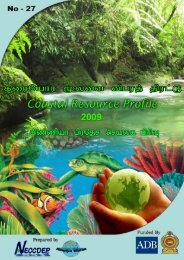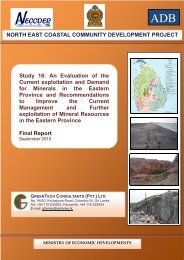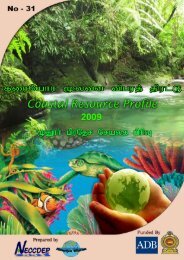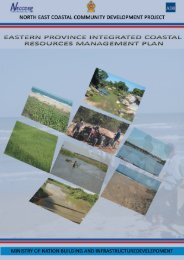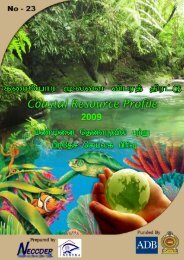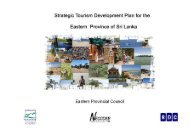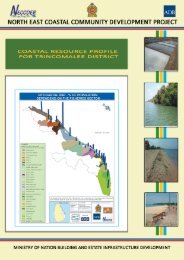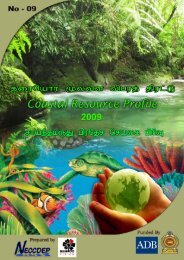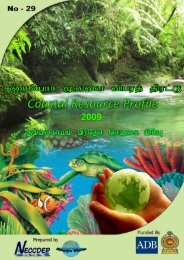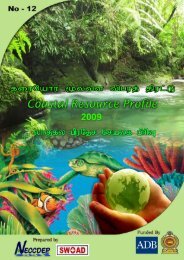Untitled - Neccdep.com
Untitled - Neccdep.com
Untitled - Neccdep.com
Create successful ePaper yourself
Turn your PDF publications into a flip-book with our unique Google optimized e-Paper software.
TRINCOMALEE BAY SPECIAL MANAGEMENT AREA Page | 47<br />
Main<br />
activity<br />
Agriculture<br />
Encroachment<br />
Coral mining<br />
Garbage<br />
dumping<br />
Threats<br />
• Loss of soil fertility<br />
• Salinity changes of<br />
water table<br />
• Habitat destruction<br />
• Shrinkage of<br />
wetland or coastal<br />
region<br />
• Habitat destruction<br />
• Floods<br />
• Loss of species<br />
• Pollution<br />
Suggestions to mitigate threats<br />
• Using organic fertilizers<br />
• Compost manufacturing and re-use<br />
• Crop rotation<br />
• Using re<strong>com</strong>mended levels of fertilizers and<br />
chemicals<br />
• Introducing water supply systems – drip irrigation,<br />
etc.<br />
• Reducing number of irrigating times to the crop<br />
• Land provisions to those not having lands<br />
• Excessive lands should be shared among land-less<br />
people<br />
• Imposing strict rules against encroachment<br />
• Using dead corals rather than live corals.<br />
• Awareness<br />
• Implementing laws and acts<br />
• Introducing new approaches and alternative ways to<br />
next generation<br />
• Compost manufacturing<br />
• Reuse / Recycle / Reduce<br />
• Burying degradable waste<br />
• Producing sub-products from the wastes<br />
4. Field studies<br />
205. After the reviews and discussions with resource persons and IP-NGO, field studies<br />
were used to collect additional information and also to fill information gaps. The field studies<br />
were carried out to identify the different ecosystems, sub-ecosystems and habitats. The<br />
results of special studies were also considered.<br />
5. Consultation with Communities<br />
206. During the field studies, individual and smaller group discussions were held at the<br />
villages and sites. The site specific issues discussed in detail with <strong>com</strong>munities and<br />
suggested solutions have also been considered in the SAM Plan. Table V.3 shows major<br />
issues and main suggestions during the consultation process. The list of individuals and<br />
associations that participated in the discussions is given in Appendix 8.<br />
207. After developing the draft plan, it was presented to <strong>com</strong>munities to get their further<br />
views and suggestions. This presentational process also ensured that the <strong>com</strong>munity<br />
participated in the revision and finalization of the SAM Plan.<br />
6. Consultation with Government Agencies<br />
208. Discussions were held with relevant state agencies which are implementing programs<br />
in the SAM area and adjoining buffer zones. Discussions were held with law enforcement<br />
agencies such as Forest Department, Department of Wildlife Conservation, Coast<br />
Conservation Department and Department of Fisheries and Aquatic Resources<br />
Development. Separate discussions were held with Divisional Secretaries whose



